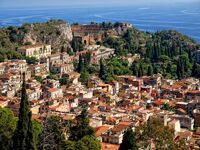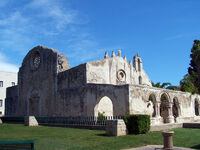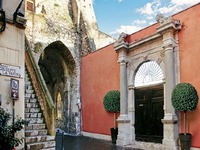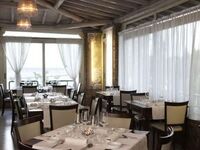As far as beach destinations go, Taormina is ancient. Located on the east coast of Sicily, Taormina was formed on a hill overlooking the Mediterranean 2,500 years ago, which means, of course, possessing a fantastic ancient theater that sits a good 3,000. Closer to the water, however, it also has a long, beautiful beach that affords one a great chance to swim come summer.
 But looming over the town is something else: Mount Etna, one of Europe’s most powerful active volcanoes. On any given day, you have a good chance of seeing it puff a little bit of smoke. Heading for a visit, volcanic activity permitting, is a great way to remind yourself about just how powerful nature can be. You need at least a week to visit Sicily; two or three days are just not enough to see Taormina and other nearby cities. The nearest airport to Taormina is in Catania, which is located to the south of Taormina, on the other side of Etna. Catania shows many traces of the volcano’s power, as it was completely destroyed by lava in 1700. In fact, there are some buildings in town where only the roof remains visible after lava inundating the rest of the structure.
But looming over the town is something else: Mount Etna, one of Europe’s most powerful active volcanoes. On any given day, you have a good chance of seeing it puff a little bit of smoke. Heading for a visit, volcanic activity permitting, is a great way to remind yourself about just how powerful nature can be. You need at least a week to visit Sicily; two or three days are just not enough to see Taormina and other nearby cities. The nearest airport to Taormina is in Catania, which is located to the south of Taormina, on the other side of Etna. Catania shows many traces of the volcano’s power, as it was completely destroyed by lava in 1700. In fact, there are some buildings in town where only the roof remains visible after lava inundating the rest of the structure.
Taormina is an exceptionally touristy place, so I suggest you not visit during the height of the season in July and August, particularly on weekends. Some say that Taormina is so crowded in these months that they hardly bother going out, preferring just to spend their time in their hotel rooms. I, for one, went in May, but even, it was still crowded. Seeing all that Sicily has to offer is probably easiest in the company of a tour guide that can be arranged through a tourist agency. A group of eight of us went through a good agency called Legendary Sicily, which is owned by an Italian man named Eddy, a life-long tour guide who knows everything from A to Z about the area’s history and geography. Packing into Eddy’s jeep, we saw everything there was to see on Etna and in the 2,500-year-old town of Siracusa, which lies toward the southern tip of Sicily, from dawn till dusk. Etna is approximately 3,500 meters high, although we climbed only about 2,000 meters of the mountain in Eddy’s jeep. At one point, there is a one-kilometer-wide and 50-meter- deep channel that was formed by a past lava flow. The black volcanic rocks left behind by the flows have been a boon to the surrounding towns, particularly for the construction industry; even the shower bath of our hotel in Taormina was made from this black rock. As we clambered about the lava flow, Eddy noted that he had seen molten lava flowing in the area 19 years ago. The nature of the lava flows created caves that are as deep as three or four kilometers and seven or eight meters high. All this activity, however, was more than a little tiring, so if you only have two or three days in Sicily, I suggest you first drop by Siracusa on your way from Catania’s airport before heading later in the day to Taormina; though you might not get to the latter until the evening, there will be more than enough chance to see Taormina on the second day. And if you have enough time (like five hours) before any flight from Catania on the third day, you can then go and see Etna. After that, grab a late lunch in Catania and peruse the city, which is located a mere 10 minutes from the airport.
SIRACUSA
 Siracusa is home to a semi-circle Greek theater from around 500 BC, from the time when the Mediterranean basin was under Greek hegemony, as well as a full-circle Roman amphitheater from around 300 BC. Both these mesmerizing wonders of engineering and architecture are located within walking distance of Siracusa. Another intriguing thing about this ancient city is the stone quarries from 2,000 years ago. Long ago, the Roman Empire – or, more precisely, thousands of slaves – opened a hole that was 10 meters wide, 25 meters long, and 100 meters deep to extract all the stones necessary for all the empire’s monuments. Truly, it is amazing to imagine how they could have managed all this work. Later, Roman emperors decided to use the cave created by the quarry as a prison.
Siracusa is home to a semi-circle Greek theater from around 500 BC, from the time when the Mediterranean basin was under Greek hegemony, as well as a full-circle Roman amphitheater from around 300 BC. Both these mesmerizing wonders of engineering and architecture are located within walking distance of Siracusa. Another intriguing thing about this ancient city is the stone quarries from 2,000 years ago. Long ago, the Roman Empire – or, more precisely, thousands of slaves – opened a hole that was 10 meters wide, 25 meters long, and 100 meters deep to extract all the stones necessary for all the empire’s monuments. Truly, it is amazing to imagine how they could have managed all this work. Later, Roman emperors decided to use the cave created by the quarry as a prison.
There is also another 2,500-year-old Greek monument with columns in the center of Siracusa. The structure was deformed after the emergence of Christianity in the region, and locals ultimately built walls around the columns, transforming it into a splendid church. Siracusa is also a good place for shopping, while there are also a lot of fancy restaurants near the seaside.
METROPOLE TAORMINA
 For our stay in Taormina, a number of locals suggested that we stay at San Domenico, a nice place with a nice garden and view, but alas, a place that has not been renovated in years. In the end, we decided to stay at the newer Metropole Taormina – a decision we would not regret. Located in the middle of the main street, Corso Umberto, the Metropole Taormina has only 22 rooms. Though a historical building, the hotel has a modern interior design. It also boasts breathtaking views of the sea – meaning you might have some problems scoring a room in the hotel. The restaurant and the bar are also terrific; and you walk out from the hotel into the center of the historic city of Taormina.
For our stay in Taormina, a number of locals suggested that we stay at San Domenico, a nice place with a nice garden and view, but alas, a place that has not been renovated in years. In the end, we decided to stay at the newer Metropole Taormina – a decision we would not regret. Located in the middle of the main street, Corso Umberto, the Metropole Taormina has only 22 rooms. Though a historical building, the hotel has a modern interior design. It also boasts breathtaking views of the sea – meaning you might have some problems scoring a room in the hotel. The restaurant and the bar are also terrific; and you walk out from the hotel into the center of the historic city of Taormina.
RISTORANTE LA CAPINERA
 Ristorante La Capinera was founded by two brothers on a location right by the water – which would especially make it the place to be on the night of a full moon. Whether for lunch or dinner, La Capinera serves up some extraordinary food. Given its excellence, it’s no surprise that it requires a reservation. The pasta in southern Italy leaves much to be desired in comparison to what’s on offer in northern Italy, but the seafood is excellent in places like Taormina. And the last word about Taormina: One simply cannot understand why there are so many churches in such a small city. So many churches, however, will afford you a chance to perhaps come across an Italian wedding.
Ristorante La Capinera was founded by two brothers on a location right by the water – which would especially make it the place to be on the night of a full moon. Whether for lunch or dinner, La Capinera serves up some extraordinary food. Given its excellence, it’s no surprise that it requires a reservation. The pasta in southern Italy leaves much to be desired in comparison to what’s on offer in northern Italy, but the seafood is excellent in places like Taormina. And the last word about Taormina: One simply cannot understand why there are so many churches in such a small city. So many churches, however, will afford you a chance to perhaps come across an Italian wedding.
FOR THE ETNA TOUR
Salita de Luna, 10, 98039 Taormina
+39 0942 620061.
Website: www.legendarysicily.it
